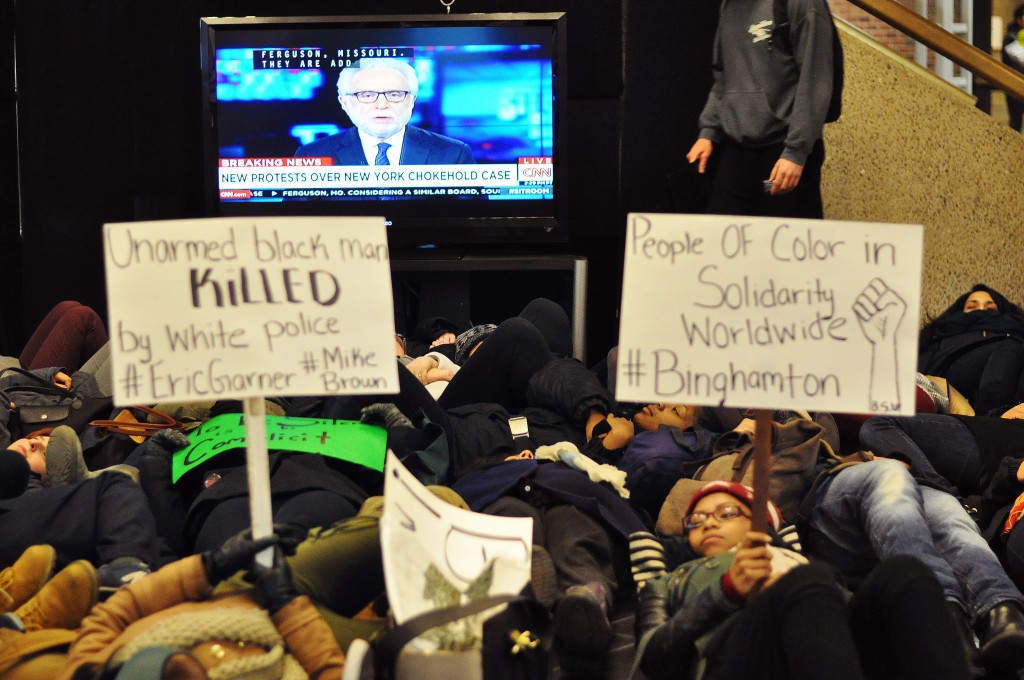
As protests were staged in New York, Missouri and across the country, hundreds of Binghamton University students came together to make their voices heard on campus.
The Binghamton Speech and Debate Team, the Black Student Union (BSU), College Democrats, Asian Outlook and many more student groups took to the Spine, Marketplace, Glenn G. Bartle Library, Tillman Lobby and East Drive in a demonstration after the police officer involved in the death of Eric Garner, a Staten Island resident, was not indicted.
Lenny Herrera, president of the Speech and Debate Team and a junior majoring in Latin American and Caribbean Area studies, said the protest was held to incite a larger conversation about racism across the country, as well as on campus.
“Binghamton students are apathetic and apolitical,” Herrera said. “And this assembly’s main purpose is to create a political consciousness on campus.”
The protest began in front of Bartle and split into two, with organizers leading groups through the Pods and Marketplace, parading signs reading “Hands Up, Don’t Shoot” and holding four minute and thirty second moments of silence, to honor the four and a half hours Michael Brown’s body was left on the sidewalk in Ferguson, Missouri before being removed.
Sam Catalano, a junior majoring in marketing who participated in the protest, said he thought it helped bring the discussion to a forefront.
“A lot of people, they post a tweet or a status and that’s it,” Catalano said. “This protest shows that we care more than that.”
Students studying in the Pods, like Zsuzsanna Orban, a senior majoring in art history, looked up from their textbooks and computers as dozens of marchers walked through.
“Having them walk through the library definitely makes other students aware that people are doing something and having a voice, and thinking about their actions,” Orban said.
Over 100 regrouped in the University Union and took to East Drive to Academic A, causing traffic jams past the Union. They staged a “die-in,” lying in the street while Binghamton Police cars watched from yards away.
Returning to the Tillman Lobby, the discussion turned to racism on campus. Speakers discussed both institutionalized racism and inflammatory comments made on anonymous forum app Yik Yak, which increased after groups staged a “die-in” in the Marketplace this past Monday.
Alim Uddin, a senior double-majoring in Arabic studies and economics and the president of the Men of Color Scholastic Society, said the responses were due to stigmas against activism on campus.
“We saw things on Yik Yak saying, ‘oh, protests don’t work,’ ‘stop disrupting things on this campus,’ ‘we’re going to see you guys hanging on trees,’” Uddin said. “These are things we don’t want on our campus.”
Herrera added that protests, while good at getting emotions high, were only the beginning of change.
“It’s not enough to do protest,” Herrera said. “We’ve had protests. Now what happens after? We want concrete political solutions to implement on campus, as well as for the populations of disenfranchised off campus, that all of America need to see.”
A town hall forum in the Old University Union following the protest allowed students to voice their experiences facing racism on campus, and ideas on how to improve BU’s approach to them.
“I think that Binghamton is one of the premiere SUNYs, and we have to be able to set an example,” Herrera said. “We talk about how we’re a diverse campus, but how can we begin to show that we’re racially conscious, and that we’re truly diverse with truly diverse ideas?”


